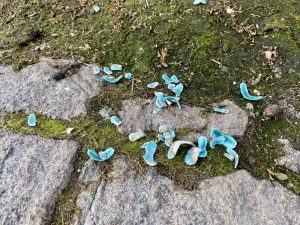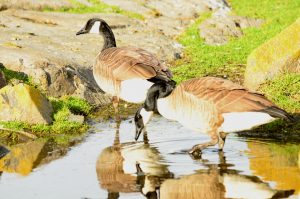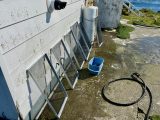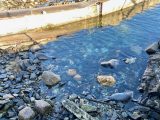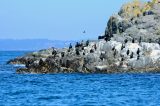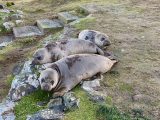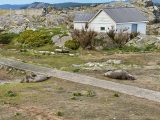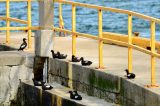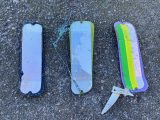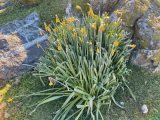Wind: yesterday W 7-31 knots, today W 6-26 knots
Sea State: both days calm in morning, 1′ chop in afternoon
Visibility: both days 8-15 NM
Sky: yesterday clear, today rain overnight then partly cloudy with rain in evening
Temperature: yesterday 6-8 °C, today 6-7 °C
Atmospheric CO2: 414.34 ppm (recorded by NOAA at Mauna Loa Observatory, Hawaii)
The population of elephant seals is increasing on Race Rocks. The boat ramp, their preferred haul out spot, is getting a lot of traffic. Yesterday morning, an adult female arrived and quickly made her way up to the centre of the island. She could be one of the females who left in January or February, based on her size and scars on her back from mating.
I realized this morning the adult female elephant seal I have been seeing on and off for the past three weeks was in fact the first mother of this winter. In the month the seal and I were both here on this island from December 21 to January 21, I never realized she had two flipper tags. I only ever saw the ones marked T562 on both sides of one of her flippers. This morning I saw two sets of different tags, one on each flipper. Perhaps the mud and snow of the early winter concealed the tags. I also did not have as many opportunities to read the tags when the mother was spending most of here time either nursing her pup or mating with the alpha male.
Now that I know she’s the mother of the male pup, it could explains why that pup came towards her when she first arrived on March 3. The other pups moved away from her. Although, I haven’t seen the male pup interact closely or vocalize with its mother.
A juvenile elephant seal arrived this morning with two green tags, E103 and E135. There is something about today that made all the tags very visible. The seal looks to be very well fed for the upcoming moulting. This seal was here in the fall. She was born and tagged in Ano Nuevo, on the coast of California between San Francisco and Santa Cruz. I haven’t been able to figure when she was born. See the log post from September 30, 2019 for ecoguardian Mara and Kai’s details of the seal they called Eric. A few weeks later, Ecoguardian Laas revealed this seal was a female and named her Erica in the log post from October 11, 2019. Naming the seals can get confusing.
While not all elephant seals are tagged, some are studied for all kinds of factors from movements to genetics to bioaccumulation and generally understanding more about this fascinating species. I am realizing as the seals move around Race Rocks, how difficult it is to tell them apart. The pups are starting to look more alike as they lose the last of their pup fur. It’s a fun game as I try to track their movements as best I can, while I move around the island doing my daily routine.
With the arrivals of seals, there was also a departure today. The youngest seal pup was outside the house last night when I went to turn off the generator and desalinator, but nowhere to be seen this morning. Perhaps she ventured out a little to far from the shallow end of the jetty bay where she has been practicing her swimming. I am curious if she will return, as two months old is a bit young to leave for good. The other two pups are still here.
There were no boats seen in the ecological reserve over the past two days. I heard a solo kayaker by the name of Travis paddled around the islands yesterday.
Here are some photos from the past two days:
-

-
Mystery solved! T562 and T563 are the same seal.
-

-
The oldest pup looking at his mother, or possibly me who is walking behind his mother. He seems to like that spot under the tallest plant on the island, possibly because he was born there.
-

-
Welcome back! The seal tagged E103/E135 next to the the older of the two female pups.
-

-
This morning through the spotting scope in the lantern room of the tower, I spied a sea otter on Middle Rocks. I’ve heard it’s rare to see them out of the water. Once the kelp grows up, otters use it as an anchor. I took this photo with my iPhone. I like the effect created around the scope, as you can see some of the island structures like the Science House and the railing of the lantern room.
-

-
“Reunited and It Feels So Good” The two adult females cosy up in the centre of the island. The bald spots on the back of the one on the right are where she has begun to moult.
-

-
The log cutting jig loaded and ready for the chainsaw. This log, cut in half before I took this photo, was the prized log I fished out of the water in the winter. The chainsaw cut through it like butter.
-

-
The wood pile keeps growing!
-

-
I changed the water filter in the residence. The water now tastes even more delicious.

